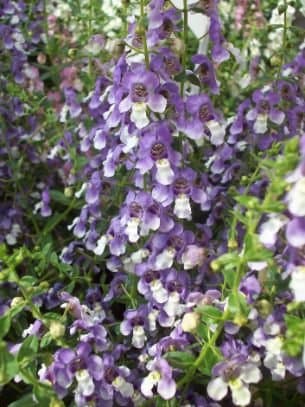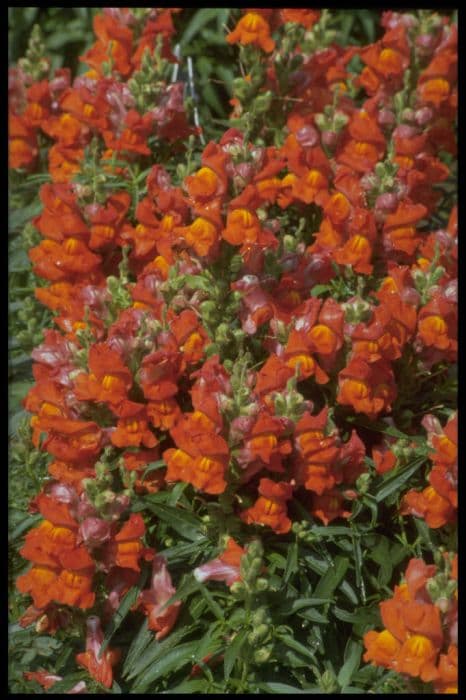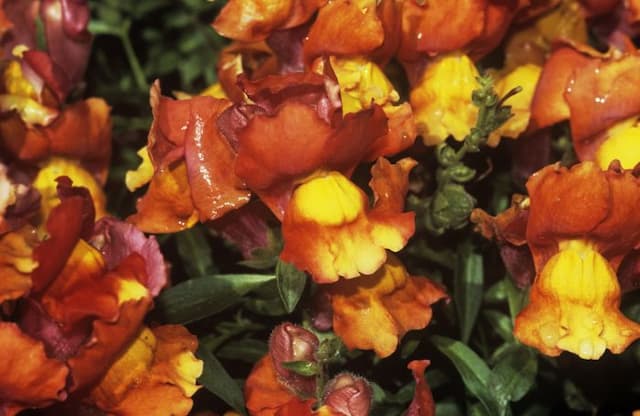Rusty foxglove Digitalis ferruginea

ABOUT
Digitalis ferruginea, more commonly known as the rusty foxglove, is a strikingly beautiful perennial plant that exhibits a rosette of downy, dark green leaves. These leaves are oblong or lance-shaped, and they elegantly clasp the base of the plant. From amidst these leaves, the rusty foxglove boasts a remarkable flower spike that carries an array of densely packed, tubular flowers. The buds open to reveal flowers that are typically a warm shade of yellow to rusty brown, often with delicate, darker veins that can create a netted appearance. These flowers are neatly arranged in rows along one side of the spike, nodding slightly downwards, providing a regal yet somewhat harmonious aspect. Inside the petals, light speckling can be seen, which serves to attract pollinators such as bees. The overall impression is of a plant that is both elegant and robust, with prominent flowering stems that stand out in garden settings and capture the viewer's attention with their exotic charm and subtle color palette. The rusty foxglove blooms in the late spring to midsummer, when it can provide a vibrant show of color amidst other garden plants.
About this plant
 Names
NamesFamily
Plantaginaceae
Synonyms
Rusty Foxglove, Iron-colored Foxglove
Common names
Digitalis ferruginea subsp. schischkinii, Digitalis schischkinii.
 Toxicity
ToxicityTo humans
Rusty foxglove is toxic to humans due to the presence of cardiac glycosides, particularly digitoxin and digoxin, which can affect the heart. Ingestion of any part of the plant can lead to symptoms such as nausea, vomiting, diarrhea, headaches, weakness, dizziness, and confusion. Severe poisoning can result in cardiac abnormalities like irregular heart rhythms which can be life-threatening.
To pets
Rusty foxglobe is also toxic to pets as it contains cardiac glycosides. If a pet ingests any part of the plant, symptoms may include vomiting, diarrhea, decreased appetite, cardiac arrhythmias, weakness, and possibly seizures. Severe cases can be fatal if not treated promptly, as the toxins directly affect the heart function.
 Characteristics
CharacteristicsLife cycle
Biennials
Foliage type
Deciduous
Color of leaves
Green
Flower color
Yellowish-brown
Height
3-4 feet (0.9-1.2 meters)
Spread
1-2 feet (0.3-0.6 meters)
Plant type
Herb
Hardiness zones
4-8
Native area
Eastern Europe
Benefits
 General Benefits
General Benefits- Ornamental Value: Digitalis ferruginea, commonly known as the rusty foxglove, features striking, elongated spikes of tubular, rusty-orange flowers which add visual appeal to garden settings.
- Attracts Pollinators: The flowers provide nectar for bees and hummingbirds, thereby supporting the local ecosystem and pollination of plants.
- Landscape Design: Due to its height and distinctive floral spikes, rusty foxglove is suitable for adding vertical interest in mixed borders or as a backdrop for lower-growing plants in a garden design.
- Drought Resistance: Once established, it is considered to be quite drought-tolerant, reducing the need for frequent watering and making it suitable for xeriscaping.
- Deer and Rabbit Resistance: The plant is generally resistant to grazing by deer and rabbits, helping to ensure that it can thrive even in areas where these animals are prevalent.
- Seasonal Interest: It provides seasonal interest with its late spring to early summer blooming period, filling a gap when other plants may not be in flower.
 Medical Properties
Medical Properties- Cardiac Glycosides: Contains compounds that can influence heart function, historically used in the treatment of certain heart conditions.
- Anti-inflammatory: May have compounds with anti-inflammatory effects.
- Diuretic: Has been associated with diuretic properties, potentially aiding in fluid removal from the body.
 Air-purifying Qualities
Air-purifying QualitiesThis plant is not specifically known for air purifying qualities.
 Other Uses
Other Uses- Wildlife Attraction: Digitalis ferruginea, commonly known as Rusty Foxglove, is known for attracting bees, butterflies, and hummingbirds, which are essential for pollination in the garden.
- Dye Production: The plant has been historically used to produce a light brownish-green dye for textiles.
- Garden Design: Due to its height and striking flowers, Rusty Foxglove is often used in garden designs to create a vertical accent or as a background plant in borders.
- Educational Tool: Botany and horticulture programs use Rusty Foxglove as a specimen to teach about plant structure and life cycles because of its clear display of inflorescence and plant development.
- Photography Subject: Its distinctive tall spires make it an attractive subject for photographers, especially those interested in capturing plant and flower imagery.
- Crafts and Pressing: The flowers of the Rusty Foxglove can be used in crafts, such as flower pressing, for making bookmarks and greeting cards.
- Companion Planting: Some gardeners use Rusty Foxglove as a companion plant to deter deer and other herbivores from more valuable crops due to its toxic properties.
- Folk Art Inspiration: The plant's unique shape and striking appearance have inspired artists and have been featured in folk art and traditional crafts.
- Symbolic Use: In some cultures, Rusty Foxglove is used symbolically in gardens and floral arrangements to signify certain emotions or messages, often related to its historical lore and perceived magical properties.
- Soil Indicator: The presence of Rusty Foxglove in the wild can indicate certain soil conditions, such as soil fertility and acidity, providing useful information for ecological studies.
Interesting Facts
 Feng Shui
Feng ShuiThe Rusty Foxglove is not used in Feng Shui practice.
 Zodiac Sign Compitability
Zodiac Sign CompitabilityThe Rusty Foxglove is not used in astrology practice.
 Plant Symbolism
Plant Symbolism- Healing: Digitalis, commonly known as Rusty Foxglove, has compounds used in medicinal treatments, especially for heart conditions. Its symbolism for healing stems from its actual use in pharmaceuticals.
- Protection: In folklore, Rusty Foxglove was thought to have protective properties against negative forces and was sometimes planted around homes for this purpose.
- Insincerity: Interestingly, Rusty Foxglove can also symbolize insincerity or a false sense of security, perhaps because the plant is toxic if ingested, presenting a beautiful yet deceiving appearance.
- Power: Due to its towering height and striking presence in a garden, Rusty Foxglove often represents power and assertiveness.
 Water
WaterFor Rusty Foxglove, water deeply but infrequently, aiming to keep the soil consistently moist but not waterlogged. Typically, this means watering once a week with about 1 to 1.5 gallons of water per plant, depending on soil conditions and climate. During periods of drought or extreme heat, watering frequency may need to increase. Overwatering can lead to root rot, so it's essential to ensure good drainage and let the soil dry out slightly between waterings.
 Light
LightRusty Foxglove thrives in partial shade to full sun. An ideal spot would be one that receives morning sunlight and dappled shade in the afternoon to protect it from the intense heat of the day. However, in cooler climates, it can tolerate full sun throughout the day as long as it's not in an area that gets excessively hot.
 Temperature
TemperatureRusty Foxglove grows best in a range of temperatures, with ideal growing conditions between 60 and 70 degrees Fahrenheit. It can survive minimum temperatures down to about 40 degrees Fahrenheit and maximum temperatures up to 85 degrees Fahrenheit, but it's crucial to avoid the extremes to ensure the plant's optimal health and growth.
 Pruning
PruningPruning Rusty Foxglove is primarily done to remove spent flower spikes and encourage a second bloom. It's best to prune immediately after the first flowering, cutting the flower stalks down to the base. Additionally, prune away any damaged or dead foliage any time of year to maintain plant health and appearance.
 Cleaning
CleaningAs needed
 Soil
SoilRusty Foxglove thrives in a well-draining soil mix with a pH range of 5.5 to 6.5. Incorporate organic matter such as peat moss and compost to enrich the soil and enhance drainage. A combination of one-third garden soil, one-third peat or leaf mold, and one-third coarse sand or perlite is ideal.
 Repotting
RepottingRusty Foxglove generally does not require frequent repotting as it is often treated as a biennial. Replanting should be done every 2-3 years or when it outgrows its container, using fresh soil mix to replenish nutrients.
 Humidity & Misting
Humidity & MistingRusty Foxglove prefers moderate to high humidity levels. While it can tolerate some dry air, it flourishes best when the local humidity is consistently above 40-50%.
 Suitable locations
Suitable locationsIndoor
Provide bright indirect light and avoid dry air.
Outdoor
Plant in partial shade, well-draining soil.
Hardiness zone
4-8 USDA
 Life cycle
Life cycleDigitalis ferruginea, commonly known as Rusty Foxglove, begins its life cycle as a seed, often germinating in temperate climates during the spring after a period of cold stratification. Upon germination, the plant enters a vegetative stage, characterized by the growth of a rosette of oblong to lanceolate leaves at the base. During its second year, the biennial Rusty Foxglove produces a flowering stalk that can grow up to 5 feet tall, adorned with tubular, reddish-brown flowers arranged in a terminal spike. These flowers are pollinated by bees and other insects, after which they set seed in small capsules. Once pollinated, the life cycle of the plant continues as the seeds disperse, usually by the action of wind or gravity. After the flowering and seeding stage, the parent plant typically dies, having completed its biennial life cycle.
 Propogation
PropogationPropogation time
Spring-Early Summer
Rusty foxglove, or Digitalis ferruginea, is commonly propagated through seed. The best time to sow these seeds is in late spring or early summer, after the threat of frost has passed. To propagate, seeds should be sown on the surface of a well-draining soil mix, as they require light to germinate. Care should be taken not to cover the seeds with soil but rather press them gently into the substrate. The soil should then be kept moist but not waterlogged. Germination can take anywhere from 2 to 4 weeks, and it's important to provide plenty of light once the seedlings emerge to encourage strong, healthy growth. Seedlings can eventually be transplanted outdoors once they are sufficiently robust and after acclimating them to outdoor conditions through a process called hardening off.









